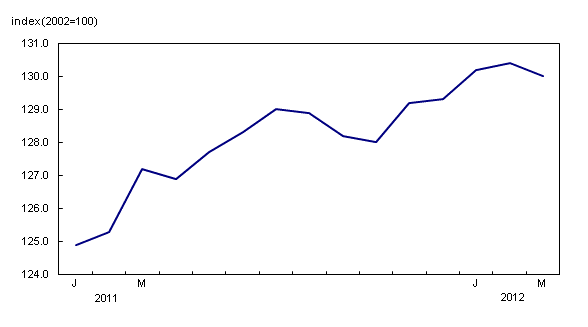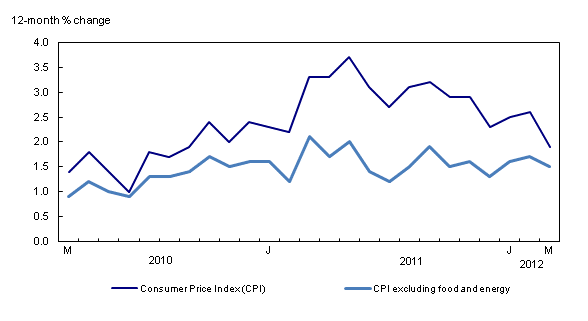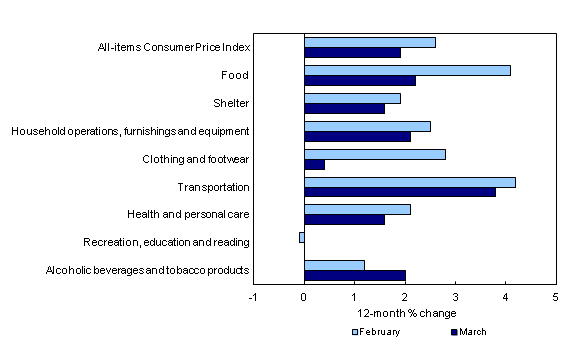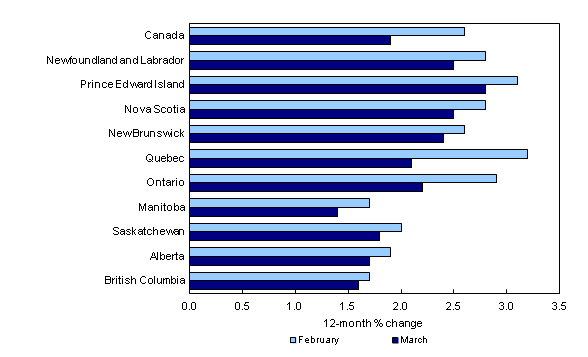Consumer Price Index, March 2012
Archived Content
Information identified as archived is provided for reference, research or recordkeeping purposes. It is not subject to the Government of Canada Web Standards and has not been altered or updated since it was archived. Please "contact us" to request a format other than those available.
Related subjects
-
[an error occurred while processing this directive]
Consumer prices rose 1.9% between March 2011 and March 2012, following a 2.6% increase in February. This 0.7 percentage point difference was largely the result of slower year-over-year increases in prices for food and energy.
Food prices rose 2.2% in the 12 months to March, following a 4.1% increase in February. This slower increase was the result of a month-over-month decline in food prices in March 2012, while a year earlier food prices had been on the rise.
The food index

Chart description: The food index
The cost of energy advanced 5.1% in the 12 months to March, after rising 7.2% in February. The year-over-year increase in gasoline prices eased to 6.6% in March, following an 8.9% rise in February. Electricity costs increased 5.3%, after rising 8.7% the previous month.
The Consumer Price Index (CPI), excluding food and energy, increased 1.5% in the 12 months to March. This increase followed a 1.7% gain in February.
The 12-month change in the CPI and the CPI excluding food and energy

Chart description: The 12-month change in the CPI and the CPI excluding food and energy
12-month change
Of the eight major components, six posted slower year-over-year increases in March compared with February. The two exceptions were recreation, education and reading; and alcoholic beverages and tobacco products.
The main factors in the 1.9% increase in the All-items CPI in March were higher prices in transportation and shelter.
Slower increases in six of the eight major components

Chart description: Slower increases in six of the eight major components
The cost of transportation increased 3.8% in the 12 months to March. In addition to gasoline, prices rose for passenger vehicle insurance premiums and for the purchase of passenger vehicles.
Shelter costs rose 1.6% compared with March 2011. Alongside higher electricity prices, consumers paid 2.4% more in homeowners' replacement costs. Prices for natural gas continued to decline.
Food prices increased 2.2% in the 12 months to March, led by gains in food purchased from stores. Prices rose 5.8% for meat and 6.1% for bread. In contrast, prices for fresh vegetables declined 15.8%, the largest year-over-year decrease since April 2008.
Prices for clothing and footwear increased 0.4% in the 12 months to March, following a 2.8% rise in February. This 2.4 percentage point difference was mostly attributable to year-over-year declines in prices for women's clothing.
The provinces
Year over year, consumer prices increased at a slower pace in March than in February in every province.
Slower price increases in all provinces

Chart description: Slower price increases in all provinces
In Quebec, consumer prices rose 2.1% in the 12 months to March, after rising 3.2% in February. The 1.1 percentage point difference was largely the result of slower price increases in food purchased from stores and gasoline.
Prices in Ontario went up 2.2% year over year in March, following a 2.9% increase in February. This slower rate of increase was largely attributable to smaller price gains in food purchased from stores, clothing and footwear, and gasoline.
In British Columbia, prices rose 1.6% on a year-over-year basis in March after increasing 1.7% the previous month. Prices for gasoline increased 6.0%, after rising 4.2% in February. British Columbia and Manitoba were the only two provinces in which gasoline prices rose at a faster rate in the 12 months to March than in the 12 months to February.
Seasonally adjusted monthly Consumer Price Index increases
On a seasonally adjusted monthly basis, consumer prices increased 0.2% from February to March after increasing 0.1% from January to February.
The index for recreation, education and reading rose 0.4% in March and the transportation index increased 0.2%. Conversely, the shelter index fell 0.2% and the index for food fell 0.3%.
Bank of Canada's core index
The Bank of Canada's core index rose 1.9% in the 12 months to March, after increasing 2.3% in February. Slower price increases for electricity and price declines in women's clothing were recorded on a year-over-year basis in March.
On a monthly basis, the seasonally adjusted core index increased 0.1% in March, after rising 0.2% the previous month.
Note to readers
The special aggregate "Energy" includes: electricity; natural gas; fuel oil and other fuels; gasoline; and fuel, parts and supplies for recreational vehicles.
The Bank of Canada's core index excludes eight of the Consumer Price Index's most volatile components (fruit, fruit preparations and nuts; vegetables and vegetable preparations; mortgage interest cost; natural gas; fuel oil and other fuels; gasoline; inter-city transportation; and tobacco products and smokers' supplies) as well as the effects of changes in indirect taxes on the remaining components.
Available without charge in CANSIM: tables CANSIM table326-0009, CANSIM table326-0012, CANSIM table326-0015 and CANSIM table326-0020 to 326-0022.
Definitions, data sources and methods: survey number survey number2301.
For a more detailed analysis, consult the publication The Consumer Price Index. The March 2012 issue of The Consumer Price Index, Vol. 91, no. 3 (Catalogue number62-001-X, free), is now available from the Key resource module of our website under Publications.
More information about the concepts and use of the Consumer Price Index are also available online in Your Guide to the Consumer Price Index (Catalogue number62-557-X, free) from the Key resource module of our website under Publications.
The Consumer Price Index for April will be released on May 18.
For more information, contact Statistics Canada's National Contact Centre (toll-free 1-800-263-1136; 613-951-8116; infostats@statcan.gc.ca) or the Media Hotline (613-951-4636; statcan.mediahotline-ligneinfomedias.statcan@canada.ca).
- Date modified:
